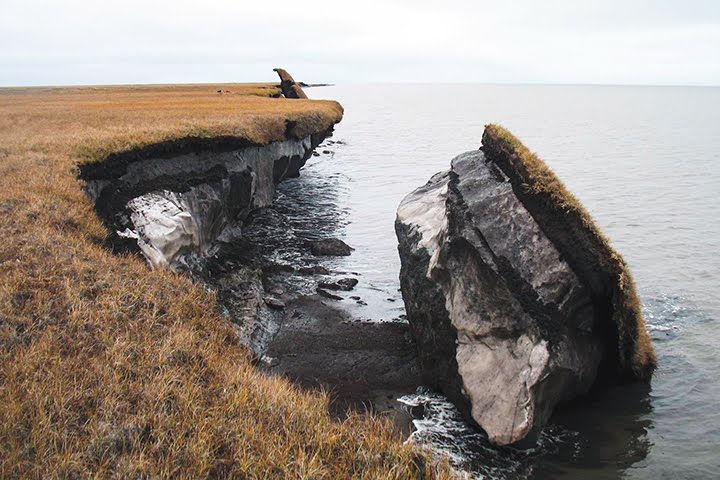
Author: Preethika Arunkumar
The Arctic region of our planet has long been a source of calm serenity, ever unchanging, inspiring generations with its vast tracts of coniferous forests and spans of ice. Underneath the northern forests, some of the soil deep below the surface of the ground is frozen and spends years beneath 32 degrees Fahrenheit. This layer is known as permafrost. Though it is a lesser-known aspect of Arctic environments, according to the Center for Biological Diversity, permafrost is essential for the health of Arctic ecosystems by “making the ground watertight and maintaining a vast network of wetlands and lakes,” which form because rainwater is unable to seep far within the ground. These bodies of water provide valuable habitat for a variety of organisms, including acting as summer breeding grounds for waterfowl and shorebirds.
However, this fragile ecosystem, along with most other ecosystems on our planet, is harmed due to the effects of fossil fuels. Since the Industrial Revolution in the 19th century, Western societies have been dependent upon fossil fuels such as coal, oil, and natural gas, as they power most of our current way of life. Fossil fuels are burned to generate power for our homes and work areas, for transportation in vehicles such as cars and planes, and to manufacture goods such as iron, steel, electronics, plastics, and clothes. Even food production and animal farming contribute greatly to emissions through energy usage, packaging, and transport.
Fossil fuels release greenhouse gases like carbon dioxide when burned, which trap heat in the atmosphere—a phenomenon known as the greenhouse effect. Methane and nitrous oxide also contribute to this effect, originating from livestock and fertilizers respectively. Chlorofluorocarbons, though now banned, persist in the atmosphere and continue to contribute to warming. Despite myths suggesting the sun is causing climate change, data from NASA shows that solar irradiance has decreased since 1960, while Earth's temperature continues to rise—strongly linking global warming to human activities, not natural solar cycles.
As Arctic temperatures rise, permafrost begins to thaw. This thaw is not uniform across the region, but it is persistent and significant. The consequences are far-reaching. Permafrost supports the weight of structures and tree roots due to its solid nature. Once it melts, the ground becomes soft and unstable. Buildings, bridges, and roads may collapse, while forests experience widespread tree tilt and fall. Water begins to drain from wetlands, eliminating vital habitats for wildlife.
Even more alarming is the discovery that thawing permafrost triggers the decomposition of trapped organic matter, releasing carbon dioxide and methane—creating a positive feedback loop where more warming leads to more thaw and even more greenhouse gas emissions. Subsea permafrost is especially vulnerable, absorbing ocean heat. Moreover, permafrost has sequestered carbon for centuries, and its sudden release may rival or exceed that of deforestation in its climate impact.
Thawing permafrost also poses biological and chemical threats. It contains ancient microbes, some possibly resistant to antibiotics, and viruses potentially still infectious after millions of years. Chemicals such as mercury and arsenic, along with banned pollutants like DDT, can be released into ecosystems as melting occurs. These pose major health risks to both wildlife and human communities, especially as Arctic populations increase and contact becomes more likely.
Our planet is changing rapidly. The effects of anthropogenic climate change extend far beyond hotter days or stronger storms. As the Arctic melts, it reveals not just ancient secrets but modern threats. The era of thinking climate change will only affect future generations is over—it’s happening now, and it’s shaping our present.
Works Cited
- “Thawing Permafrost” – Center for Biological Diversity
- “Causes and Effects of Climate Change” – United Nations
- “Main Greenhouse Gases” – Center for Climate and Energy Solutions
- “Causes” – NASA Climate Science
- “Climate Change Indicators: Permafrost” – US EPA
- Wild, Birgit et al. “Organic Matter Composition and Greenhouse Gas Production...” – Nature Communications
- Miner, Kimberley R. et al. “Permafrost Carbon Emissions...” – Nature Reviews Earth & Environment
- Miner, Kimberley R. et al. “Emergent Biogeochemical Risks...” – Nature Climate Change
- “Permafrost Thaw Could Release Bacteria and Viruses” – European Space Agency